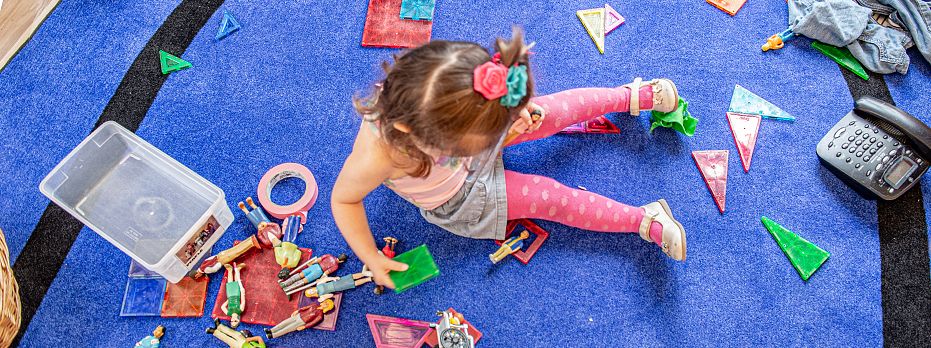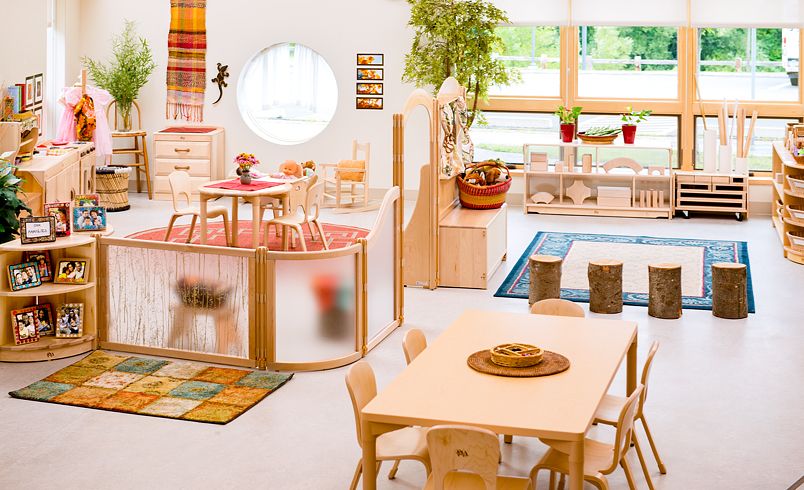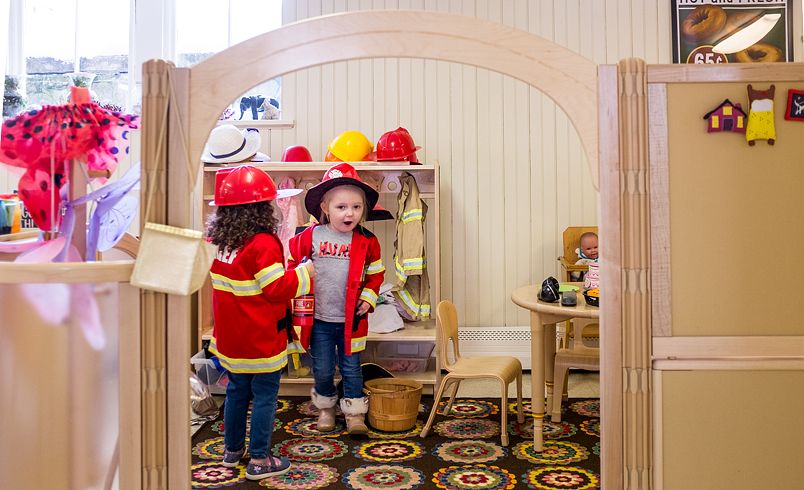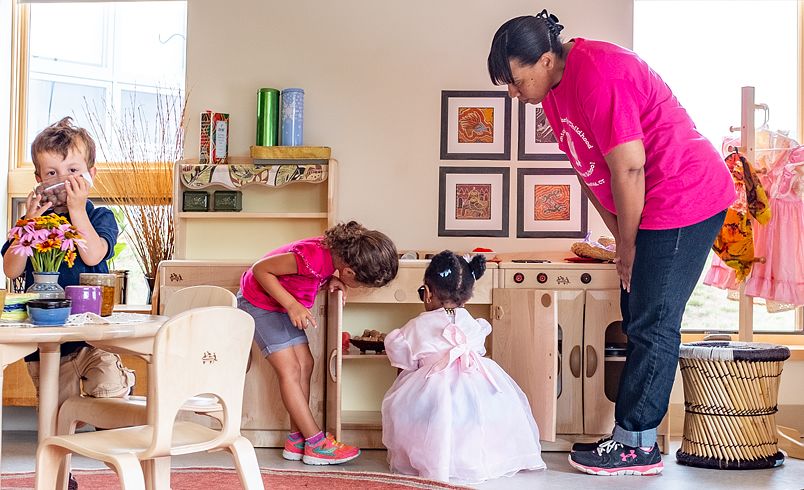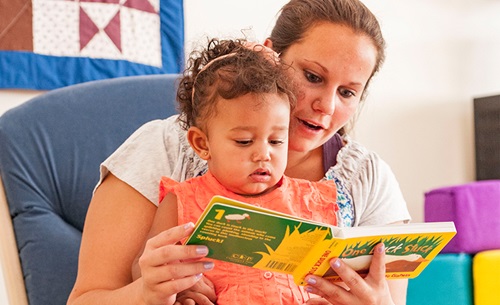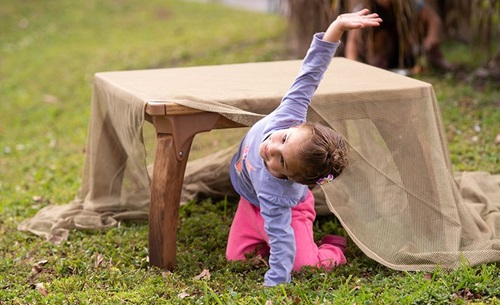Waving Your Magic Wand
Strategies for Minimizing Challenging Behaviors
| October 2019It is arrival time in the Pre-K classroom. As children enter the room they head over to small area rugs that have puzzles, books, and tubs with Lego® blocks for them to work with until it is time for large group time to begin. Cheerful noise fills the room. Suddenly a chorus of “Teacher, Teacher” fills the air and Ms. Smith rushes over to discover that Jason has knocked over a block tower that Cory and Amanda worked hard to build. While Ms. Smith is talking to Jason, Carrie begins to race around the room flapping her arms and shouting, “I’m a butterfly, watch me fly!” In doing so, she ruins the puzzle Nico and Jay have been working on and runs into Nellie, who has a cast on her leg and is using crutches.
As the morning progresses, children dump materials from the centers all over the floor and loudly argue with one another over whose job it is to clean up the mess. Susie follows Ms. Smith from incident to incident complaining that no one wants to play with her. Finally, it is lunchtime—but rather than bringing happy relief to the morning’s chaos, the children’s behavior is far from ideal. Adam spits watermelon seeds at the boy sitting across the table from him and other children soon copy his behavior. Hopes of a peaceful naptime fizzle quickly when several children jump up from their cots and pull toys from nearby shelves. Occasional loud crashes made by dropped toys make it impossible for most of the other children to sleep. By the end of the day, Ms. Smith begins to think she may need a magic wand to change some of her students’ behaviors.
Does this day sound familiar? All too often teachers spend so much of their day reacting to behavior issues that they wonder if there will ever be enough time to teach the curriculum in their lesson plans. Unfortunately, there is no magic wand to suddenly make everyone’s behavior perfect, but there are a variety of strategies teachers can employ to prevent challenging behaviors and minimize them when they occur.
Preventing Challenging Behaviors
The physical layout of the classroom is particularly important because if it is well thought out, organized, and developmentally appropriate, there will be fewer opportunities for anyone to engage in challenging behaviors. On the flip side of that coin, children in poorly organized classrooms depend on the teacher for guidance—all day long. Their teacher will spend a great deal of time and energy directing group behavior and will have considerably less time to work with individual children. Exhausting! The following strategies will help to create a physical environment that is less conducive to challenging behaviors.
Center placement needs to be strategic. Quiet centers such as reading, writing, and counting need to be as far away from noisy ones as possible to minimize interruptions. Centers such as dramatic play and blocks need to be far enough from quiet areas so that children working in those areas are not constantly interrupted, which can lead to frustration. Messy centers such as art and science need to be close to the classroom sink. A clothes drying rack with clothespins needs to be next to the easel or art table so creations can be hung up without carrying them through the classroom with paint dripping everywhere. If there is no sink in the classroom, placing messy centers close to the classroom door will make the trip to wash hands faster and, in turn, less likely to disturb children working in other centers.
Avoiding “too much too soon” means that you will need to hold back and limit what is on view in your centers during the first days of school. Few things are as frustrating as having carefully planned centers misused and items damaged, lost, or destroyed. This can easily be prevented by covering up all centers with sheets prior to children’s arrival on the first day of school. Explain to the children that you will “unveil” a new center each day. The “unveiling” will include a guided tour of the center, clear instructions of how materials can be used, and your clean up expectations. I highly recommend labeling each shelf with the name of the item as well as a photograph of the item so children know exactly where to place items during clean up. Until all of the centers are “unveiled”, baskets holding puzzles, books, crayons, art paper, and other small items can be utilized at tables.
Boundaries between centers need to be clear to all. These can be pieces of furniture, small carpets, sheer curtains, shower curtains, or colorful duct tape on the floor. It is not important what you use—it is only important that children recognize the boundaries without constant verbal reminders. These boundaries allow children to focus on one center at a time.
Limiting the number of children at a center is important because it gives those in the center an opportunity to concentrate on what they are doing without feeling overwhelmed by others trying to use the same center. Setting limits can be accomplished in a number of ways. Some teachers separate children into groups of four and rotate the groups from center to center. Others dismiss children one at a time from large group time and encourage them to self-select centers. A sign placed next to each center indicates how many children can work there at once. Each sign needs to include a number and a corresponding number of dots next to the number so children can independently judge for themselves whether or not there is enough room at the center for them.
Eliminating runways by placing centers throughout the classroom rather than locating them around the perimeter is an important strategy. Having a large empty space in the middle sounds like a great idea for group activities, but it often means that teachers spend a great deal of time each day reminding children to “use your walking feet.” It is more practical to nestle a group area in a corner of the classroom surrounded by bookcases or other type of divider. A chair with a “Closed” sign can be placed across the entrance when it is not in use.
Private spaces where children can go to calm down and relax are common in many classrooms. This is a wonderful idea, but care must be exercised when this area is planned to ensure it gives children privacy while the teacher can still see what is going on at all times. This means that tents, log cabins, or igloos are not ideal. An opaque shower curtain hung from the ceiling is a better option because it provides some privacy while allowing for supervision.
Visual schedules are important in early childhood classrooms because knowing what to expect gives children a sense of control and security. Imagine finding yourself in an unfamiliar room without a clock and wondering when you will next eat, use the bathroom, or go home—it would be disconcerting. A pocket chart with sentence strips is an easy way for young children to track their day. A picture of the activity next to the name allows all children to “read” the schedule. Be sure to laminate the sentence strips so they can be used over and over. Each morning the appropriate strips are placed in the pocket chart in chronological order. Extra strips for pull-outs such as music or outdoor time, as well as special events, can be added as needed. A brightly colored clothespin for the “schedule helper” to move along during the day helps children to keep track of what is going to happen next.
Engage children in making classroom rules. Circle time on the first day of school is the ideal time to ask children, “How should people behave in our classroom to keep everyone safe?” All responses should be accepted and visually recorded. The younger the group, the more likely it is that responses will be a long list of “don’ts” such as “don’t bite, don’t hit, and don’t spit.” Once the list is complete, read it back to the children and ask them, “These are all important things we should not do, but what CAN we do to keep everyone safe?” Guide children in coming up with three or four positive ways of behaving in the classroom such as: Walk in the classroom, keep hands to yourself, and be nice. Write them on a poster size sheet of paper, read them out loud, and have each child sign her name or make her mark on the paper. Engaging children in making their own classroom rules gives them ownership of the process and makes it much more likely that they will be followed.
Addressing Challenging Behaviors
No matter how well classrooms are planned, there will be those days when challenging behaviors seem to abound. The term challenging behavior often evokes images of children turning their cards, writing their name on the board, or sitting along the fence at recess. Underlying each of these strategies is the premise that children will be shamed into doing the right thing next time. Unfortunately, these strategies are rarely effective in vanquishing unwanted behaviors because young children have difficulty attaching a logical connection between dumping crayons on the floor and sitting by the fence at recess.
Logical consequences, on the other hand, are responses that relate directly to the behavior in question. For example, if four-year-old Cody runs in the classroom and knocks down another child at 9:30 in the morning, writing his name on the board and making him sit by the fence during afternoon recess does not make sense. Most likely Cody will have forgotten about his transgression by then and will serve his time without making a meaningful connection between his action and the consequence. It is likely that he will repeat the behavior. It is also highly likely that Cody will feel resentful of his teacher and begin to lose his enthusiasm for coming to school or following the rules because they do not make sense to him.
A logical consequence would be to first attend to the child who was knocked down and, second, ask Cody to attempt to repair the damage caused by his actions. He could assist the injured child by getting a wet paper towel for an injured knee, help rebuild a block tower that was knocked down, or simply sit with the injured party until he feels better. This strategy allows children to make amends for their actions while still viewing themselves and being viewed by others as capable and responsible people.
Picture cues are helpful for children who have difficulty following verbal directions. A lanyard worn around the teacher’s neck that features small pictures of common behaviors such as lining up to go to the bathroom, cleaning up centers, or sitting on the rug at group time can be helpful. Simply making eye contact with the child and pointing to a picture depicting the desired behavior can be helpful.
Proximity is another means of quelling challenging behaviors. Simply standing next to a child often works wonders in helping her remember what is expected. You do not have to say a word! Amazing.
Time-out can also be effective in removing a child who is exhibiting a challenging behavior from a particular situation. Time-out needs to be carefully imposed and not used to exile a child to Siberia on a daily basis. Sometimes children need to step away for a few minutes to gain control of themselves. There were times when my first graders were sitting in a group and someone simply would not keep his hands to himself, quit talking, or similar distraction. After one reminder of what behavior was expected, I would simply ask the child to sit at the nearest table for a few minutes and rejoin us when he could follow the rules. This gave the child a time away while still remaining close enough to hear what was going on AND the child had a choice about when to rejoin the group. One problem with exiling children in time-out for long periods of time is that the other children begin to view them as “bad” and may begin to exile them from play and friendship. In the end, it just makes the problem worse.
Time-in differs from time-out in that the child is asked to sit down close to the teacher and remains there until she is able to control herself. This strategy is helpful in quelling misbehavior and eliminates the chance of forgetting them in time-out.
Finally, often those children who test our patience the most are most in need of our compassion and support. But teachers are human and it is difficult not to get frustrated when someone has figured out how to push your buttons. A strategy called Pennies in Your Pocket (Kaiser & Rasminsky, 2012) helps break the pattern of negative interactions with a particular child and, instead, foster a positive teacher-student relationship. Start out each day with ten pennies in your right pocket. Every time you have a positive interaction with this particular child, place a coin in your left pocket. The goal is to move all of the pennies by the end of the school day. Doing this activity reminds you to look at the child in a positive way and eventually build a positive relationship.
References
Follari, L. M. (2014). Foundations and best practices in early childhood education (3rd ed.). Upper Saddle River, NJ: Pearson.
Kaiser, B., & Rasminsky, J. S. (2012). Challenging behavior in young children. Upper Saddle River, NJ: Pearson.
Kostelnik, M. J., Gregory, K. M., Soderman, A. K., & Whiren, A. P. (2012). Guiding children’s social development and learning (7th ed.). Belmont, CA: Cengage Learning.
Marion, M. (2015). Guidance of young children (9th ed.). Englewood Cliffs, NJ: Pearson.
Trawick-Smith, J. (2013). Early childhood development a multicultural perspective (6th ed.). Upper Saddle River, NJ: Pearson Prentice Hall.
Copyright © Exchange Press. Reprinted with permission from Exchange magazine. All rights reserved. Visit us at www.ChildCareExchange.com or call (800) 221-2864.

